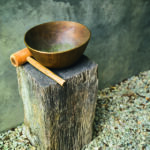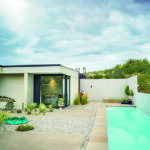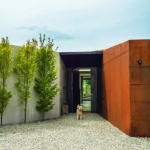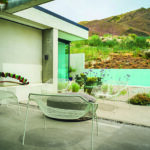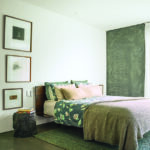A couple enjoying the fruits of semi-retirement on the side of the Kawarau River
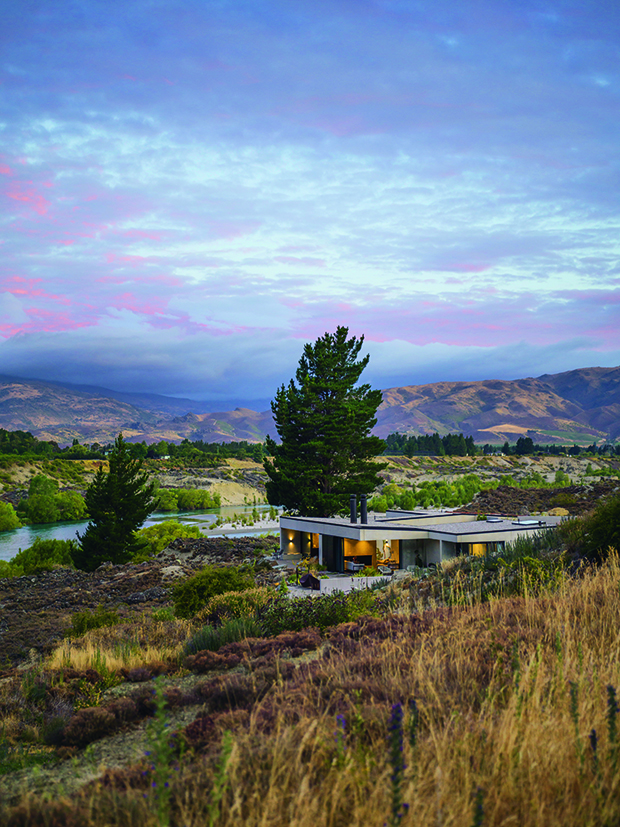
Mirani and Rod Keillor’s award-winning house, designed by Bergendy Cooke, tucks into its site alongside the Kawarau River. Easy-care plantings such as feather reed grass, blue grass, purpletop vervain, sage and lavender meld into the natural landscape.
This oasis on the edge of the Kawarau Gorge has evolved over the decades into a retirement haven for the owners — although that doesn’t mean they’re slowing down.
Words: Claire McCall Photos: Rachael McKenna
Wine. Truffles. Olives. And an award-winning home beside the river. These are the trappings of a life well lived. But for Rod and Mirani Keillor, people are the real joy of retiring to this 25-hectare property in the Kawarau Gorge. He tāngata, he tāngata, he tāngata. “We feel very privileged that, as a result of making wine and growing truffles, we have met so many fascinating people — people who are doing, and have done, interesting things in their lives,” says Rod.
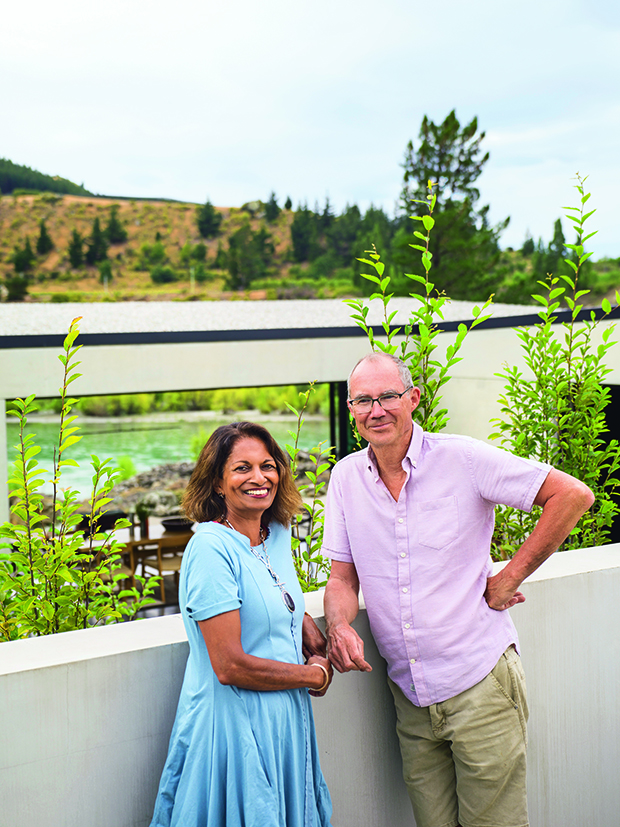
Rod and Mirani have slowly developed Black Quail Estate over the decades and, now that they are “retired”, plan to open the winery by appointment to visitors.
Now that Rod, an ophthalmologist, and Mirani, an accountant and his office manager, no longer run their Dunedin-based practice, they can spend more time here at the end of a two-kilometre dirt road among the vines and hazelnut trees. Yet, while they may pay lip service to the idea of slowing down — “I just want to be this year; to enjoy what we have,” says Mirani — they are far from idle. The rich tapestry of rural living makes sure of that.
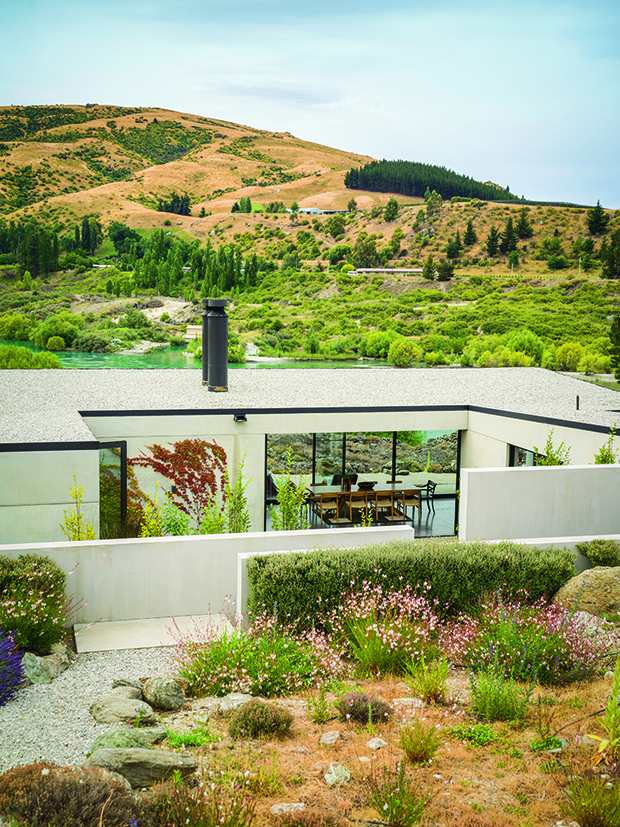
A stairwell leads from the wine cellar to the wildflower garden where vipers bugloss, lavender and gaura hold court. The insulated steel roof features Kawarau River shingle.
The couple met at a mutual friend’s flat-warming party in the mid-1980s when Mirani caught the eye of a dashing young registrar. “I thought she was attractive because she was such an interesting person — despite her Diana Ross-style permed hair,” Rod laughs.
Emigrating to Invercargill from Sri Lanka as a 13-year-old would certainly develop character. It was winter, and Mirani was thrown in the deep end at intermediate school, where she was the only pupil with English as a second language. “Culturally, it was very different — I had a kilt and a blazer to wear as a uniform. My mum had to learn how to modify a lamb roast with spices. Moreover, in the 1970s, coconut milk — a fundamental of Sri Lankan cooking — was not to be found.”
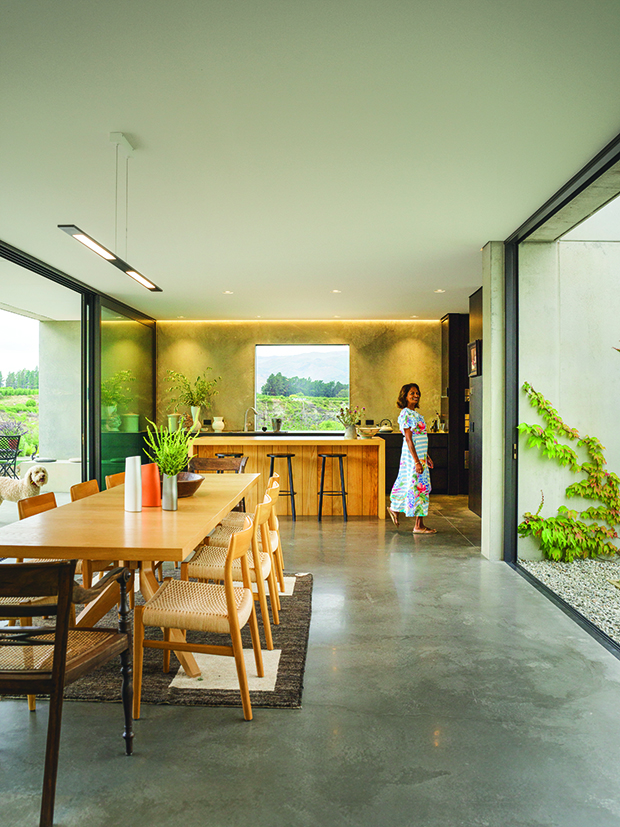
Polished concrete floors keep the living spaces cool in the height of summer. A picture window on the kitchen’s back wall frames a view of the river and the Cairnmuir and Dunstan ranges.
Naturally optimistic, Mirani readily made friends and the Fernandos, one of eight or so Sri Lankan families in the town, soon became a valued part of the community.
“I always say about Invercargill, ‘Cold weather, warm people’,” she comments.
- Mirani takes a ride with truffle dog Nico in her vintage 1961 MG. She purchased the car in honour of her mother-in-law, who had long lusted after the marque but never bought one. It was initially red but has been restored to an MG cream.
- A bell bowl in bronze by Nelson artist Nicholas Duval-Smith is used as an entrance door gong.
- Rod designed the black water feature in the courtyard using pourable granular pond colourant to reflect the sky. The two green pots are by Yannick Fourbet (NZ Life & Leisure, May/June 2018), also known as The French Potter, a good friend of the couple.
Although they travelled with Rod’s career — to London, where their first child was born — urban living held no sway. “Land has always been important to me,” says Rod. “I was brought up rurally, and my father was a market gardener.”
So, in 2000, when sections that were once part of the Mt Difficulty sheep run lowland came up for sale, Rod was keen. He wanted to grow walnuts and maybe some grapes. This property, where once prospectors washed for gold, had a lovely sunny terrace overlooking the river. It seemed perfect.
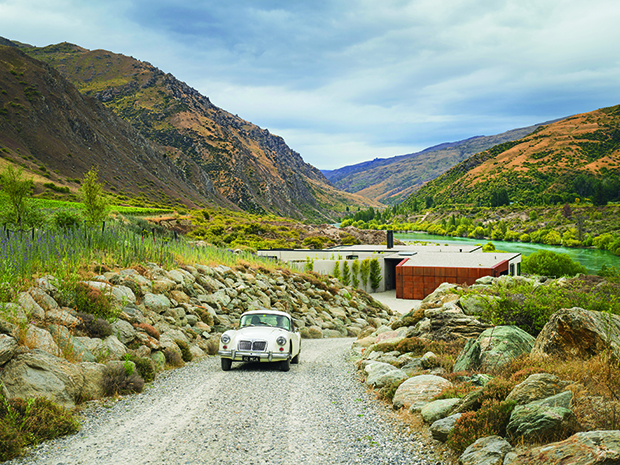
The boulders that line the driveway were excavated from the site during the house’s construction.
As it turned out, walnuts were a no-go (the industry did not have the infrastructure at the time), but wine — well, their nine hectares of pinot plantings have proved a winner. “At first, we thought we’d just grow grapes and sell them, but others were making such good wine from our fruit that we got a winemaker involved,” explains Rod. Fast forward 10 years, and their Black Quail Estate Pinot Noir, of which they still only make 400 to 500 cases, earned several gold medals and the best pinot noir trophy at the 2016 Romeo Bragato Awards.
- The pool, a sliver of blue within the tawny courtyard, is for 15-metre laps. Rod and Mirani swim all through summer, and it’s the perfect drawcard for a long, cool G&T.
- In the entry courtyard, the garage is wrapped in rolled steel, and hornbeam trees will grow to soften the exterior wall.
- The couple did all the landscaping themselves, choosing hardy plants that could survive weather extremes. The crinkly top art (above) is called Kronkelen and is by Madeleine Child.
Although Mirani, in particular, enjoys spending time with friends in Dunedin, where the couple own a 110-year-old Arts and Crafts home, the pull of the country is becoming irresistible. Part of the magnetism is the house — a 2019 Home of the Year winner designed by Bergendy Cooke — where the principles of Sri Lankan architect Geoffrey Bawa are made manifest within the Central Otago backdrop.
“Both Rod and I have been a huge fan of his for decades,” says Mirani. “And I didn’t want a conventional home; I wanted one based on courtyards.”
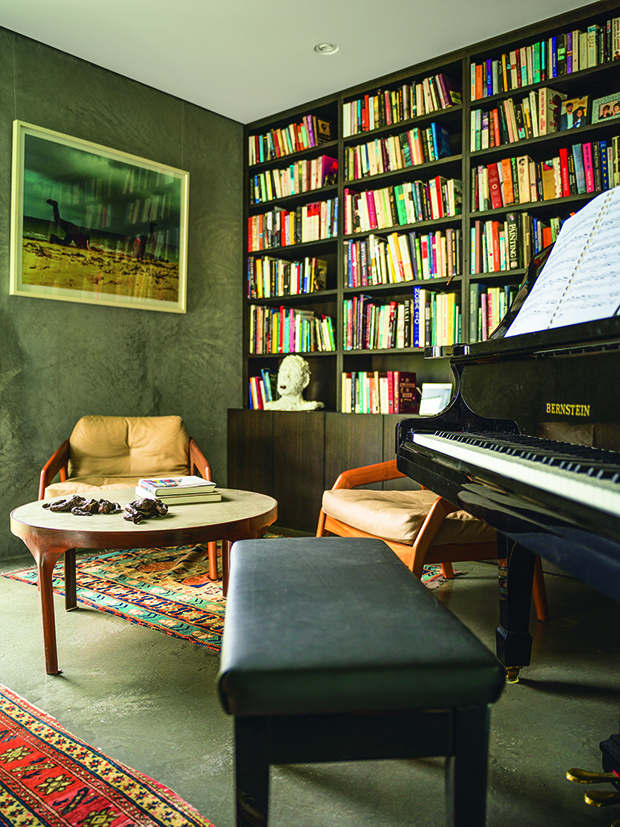
In the library and piano room, a sculpture by Rod entitled Fallen is overlooked by a photograph by Miranda Bellamy called Head in the Sand. “Now that I am spending more time here, I hope to be able to practise the piano more regularly,” says Mirani.
East, west and central courtyards ensure that whichever way the wind blows, the Keillors can feel at one with this dramatic landscape — and enjoy it. The couple has started a veggie garden in steel tubs, and lavender, hornbeams and boston ivy in the courtyards are not that thirsty in the parched climate.
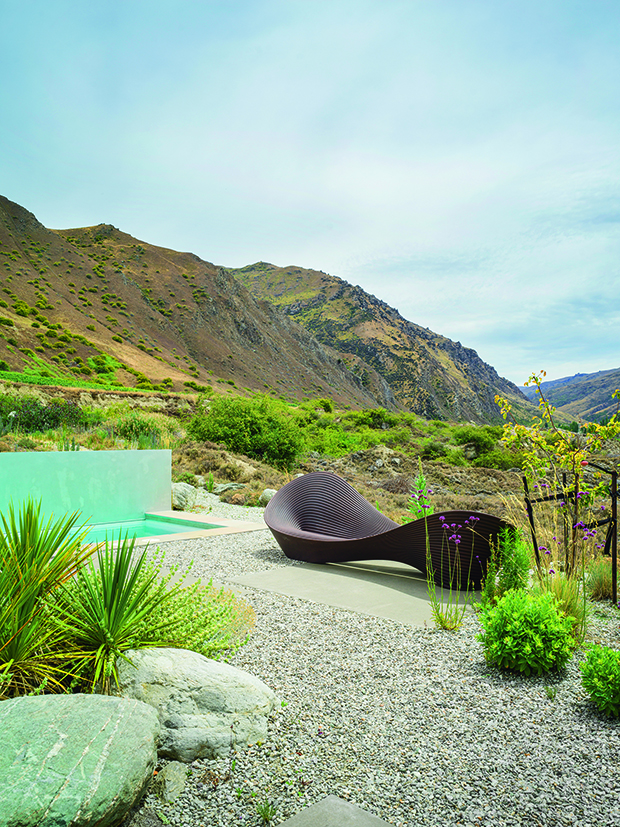
The Keillors left plenty of space for art and the artful on the exterior, including a Folly Bench by Magis, from ECC.
Beyond the garden, where lichens ramble over the stacked stones and wild thyme turns lilac in November, there’s a 40-tree olive grove with varieties, such as Mission and Uovo de Piccione, initially planted for pickling but which are now pressed into peppery oil.
Rod freely admits they are what he calls “Queen Street farmers”, and so “experimental” is a word that probably underpinned much of their planting in the beginning. The one-hectare truffière was one such trial. A patient who was a guru of this funky fungus did some soil experiments on the property and pronounced its potential. “Let’s give it a go,” said Rod.
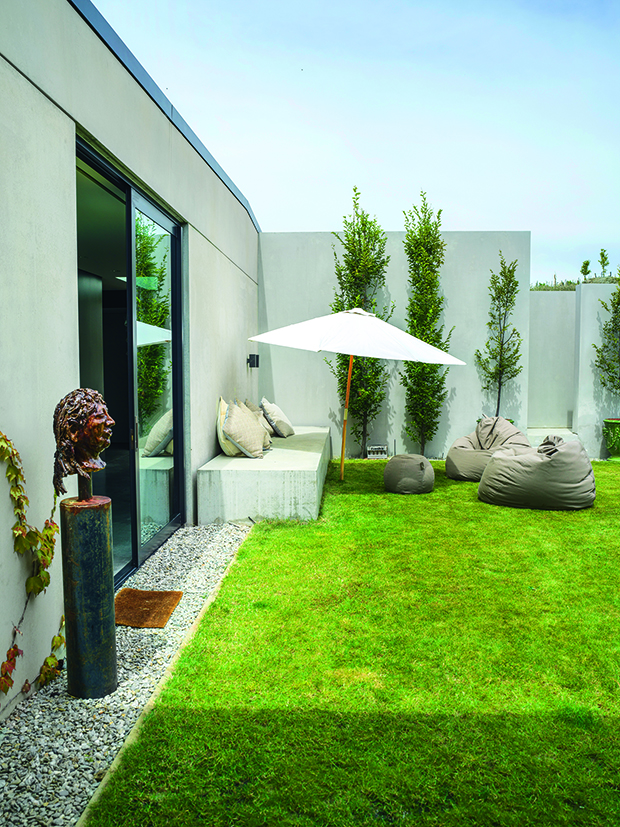
Near a built-in sitting area outside is another of Rod’s early sculptures completed at art school night classes. Inspiration came from the Otago Daily Times’ sports pages, where a young soccer player is watching to catch a ball high in the air.
After five years, the truffle-inoculated hazelnut trees weren’t producing the goods. They waited some more. After 10 years, they were about to label the venture a folly when their patience paid off. The truffle dog they had hired for the job sniffed out a beauty. They were in business. “Since then, our truffle production has increased every year,” says Rod. And Nico, their current hound with a nose for snuffling out the edible black gold, responds well to encouragement. “He gets chicken hearts whenever he finds one,” says Mirani.
- Natural plaster and strip lighting make a statement in the stairwell.
- New Zealand-made Lujo loungers are wave-like in form, and Rod’s jackrabbit (a painting completed during the pandemic lockdown) overlooks them.
- The wall behind the freestanding bath is cast concrete slab. The flower artwork on the vanity is by Suzanne Scott Butson Ceramics.
- Etchings by Grahame Sydney that Rod collected while he was a med student hang on the wall of the main bedroom.
The chefs who visit to learn about truffles have enriched the couple’s lives. “Eight years ago, it was rare to find truffle on a menu — it was mainly chefs trained in Europe who knew precisely what to do with the product — but things have changed.”
Apart from their truffles appearing in high-end restaurants, Rod and Mirani are keen to introduce them to the everyday kitchen. “Many people only know of truffle oil, where they manufacture one of the flavour compounds and mix it with oil. It smells very pungent.But the smell of real truffle is not as strong; it’s subtle, and complex,” says Mirani.
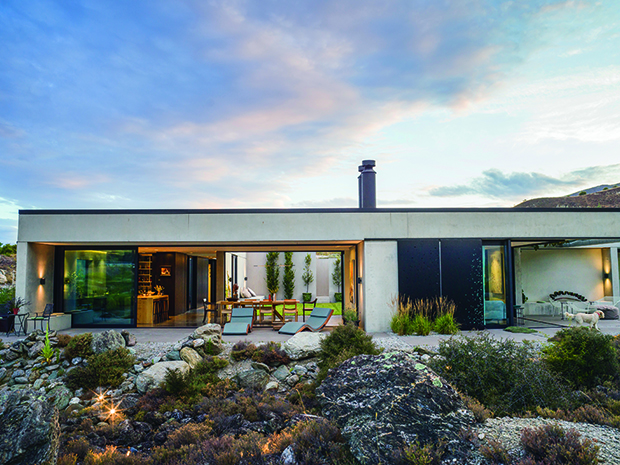
The washings (leftover from gold panning in the area) that surround the house lend atmosphere to the exterior and are of historical significance.
When the pair are not being sociable, there is time to pursue individual pursuits. Mirani, who has been learning piano since the age of eight, is hoping for more time to practise. Meanwhile, Rod, who collected the art of Grahame Sydney even before he met Mirani (“etchings, not paintings, unfortunately”), has long studied fine arts himself, attending a part-time sculpture and ceramics course at Otago Polytechnic. His heads and busts are dotted about, on shelves and surfaces inside and out, and their contorted faces are something of a surprise. “I get inspiration from photos, particularly from the sports pages of newspapers. I am fascinated by facial expressions.”
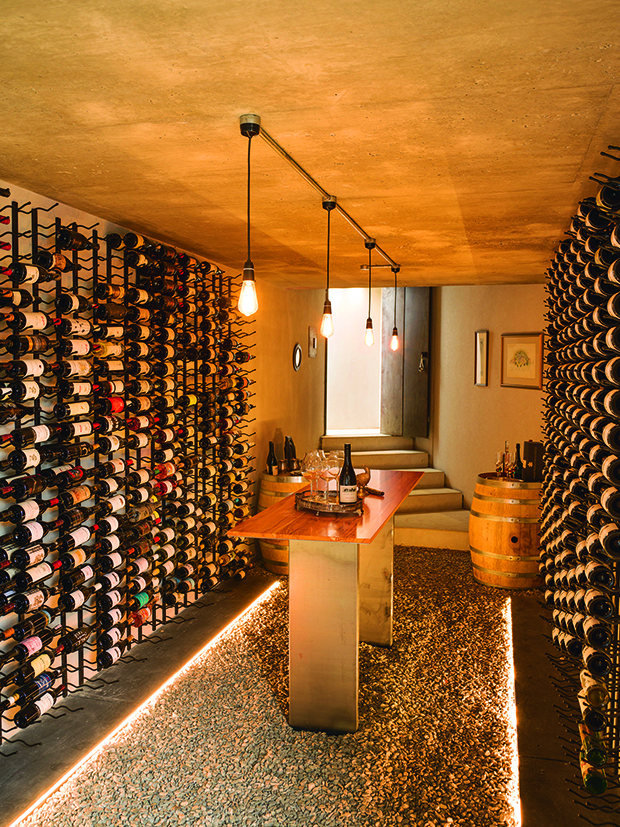
The couple’s wine collection includes some samples of their own Black Quail Estate Pinot Noir dating back to 2004. Their pinot noir has been described as rich and vibrant with complex and fragrant flavours of dark raspberries and herbs, fine structure and underlying power. The other side of the cellar is stocked with favourites from around the world — perfect for a pre-dinner aperitif with friends.
This one-time eye surgeon has incredible fine motor skills, so he seems a natural in this 3D format. But his painting of a magnificent jackrabbit, which hangs on the wall of the dining area, is just as eye-catching.
The couple’s daughter recently married here at an altar set up so that the landscape became part of the ceremony. Preparing the property for the wedding was a labour of love. Now they are trying to take their foot off the pedal but there’s simply too much of interest to get stuck into. As one neighbour remarked when he saw Rod’s painted jackrabbit, “That can’t be a Central Otago bunny; our local rabbits won’t sit around that long.”
COME TO BANNOCKBURN
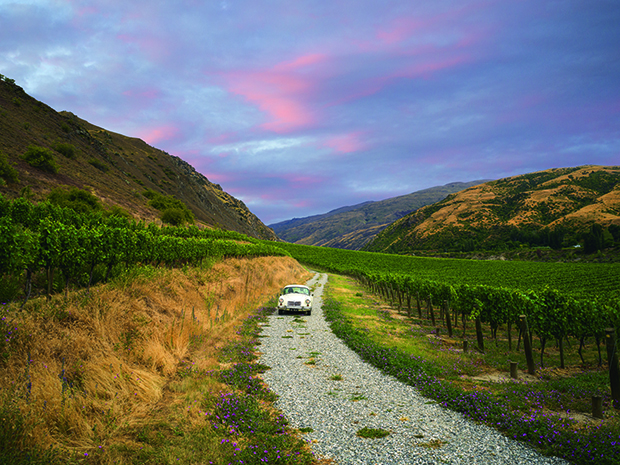
Mirani loves to drive her MG to lunch at Desert Heart Vineyard — “our local” — further down Felton Road.
Mirani and Rod find there’s no shortage of things to see and do in the Kawarau Gorge area.
Here are some of their tips:
• Visit vineyards and wineries for tastings and lunches. “We love lunch at Carrick Restaurant, Desert Heart and Mt Difficulty,” says Mirani.
• Walk along the Sluicings Track on Felton Road.
• Explore the Lake Dunstan Trail, which goes through Bannockburn.
• Check out the annual Across the Bridge Arts Festival.
• Go jet boating on the Kawarau River.
• Visit the OCTA Gallery in old Cromwell and Fusion Ceramics in Bannockburn.
• Have a coffee. “Our favourite coffee place is Pinot Junction in Old Cromwell — we can walk there from our house along the cycle track.”
WHAT TO DO WITH FRESH TRUFFLE
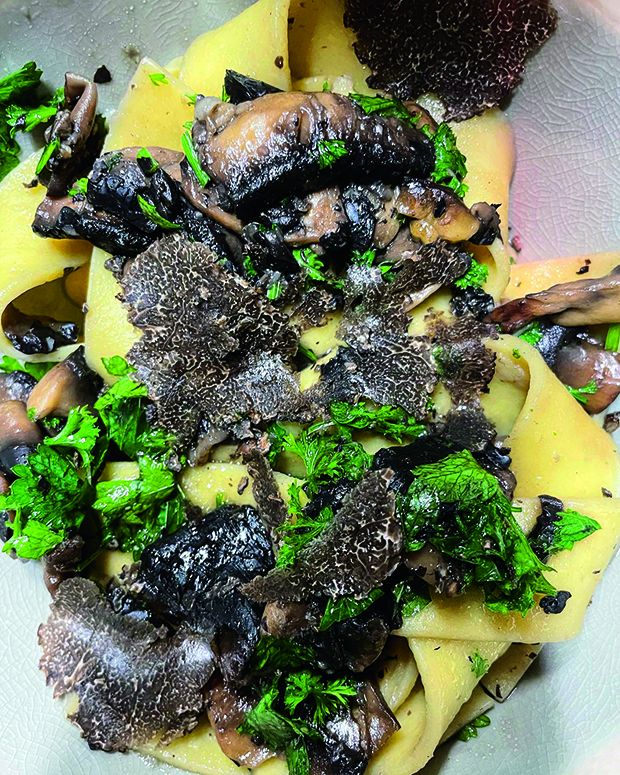
• Grate a few scrapings over scrambled eggs and serve on sourdough toast for a luxurious morning treat.
• Make the famous Black Widow dish: insert butter and truffle slices under the skin of a whole chicken and then roast.
• For a deliciously impressive 30-minute meal, fry some sage leaves in plenty of melted butter, then add some fresh truffle to the mix. Pop some precooked pasta into the pan and finish with some parmesan.
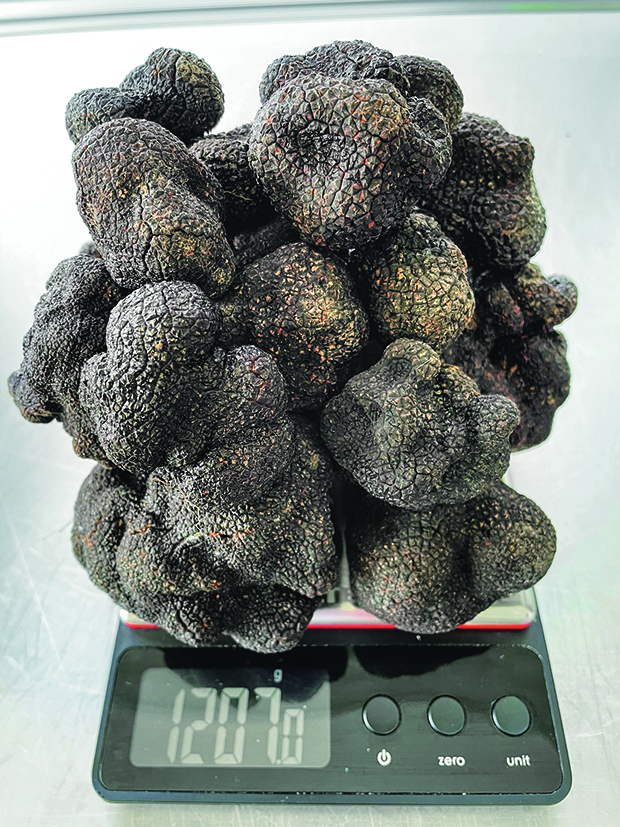
• Fold some finely grated truffle and fine sea salt into softened unsalted butter.
• Preserve leftover truffle pieces by grating and folding them into soft cheese or butter. Then freeze. blackquail.co.nz
Love this story? Subscribe now!
 This article first appeared in NZ Life & Leisure Magazine.
This article first appeared in NZ Life & Leisure Magazine.

